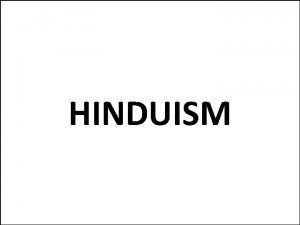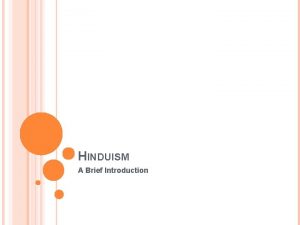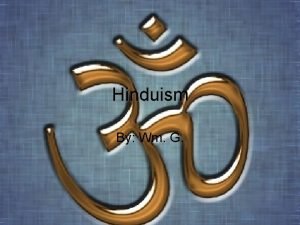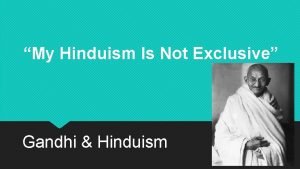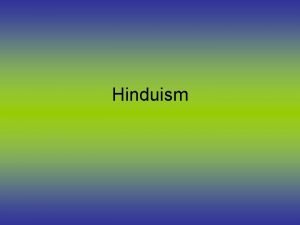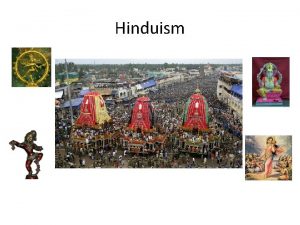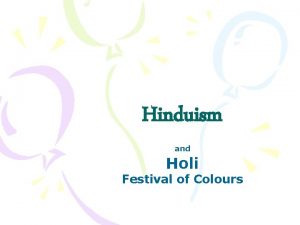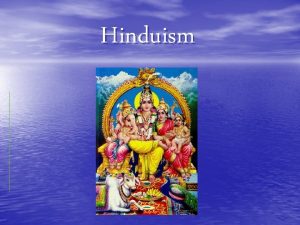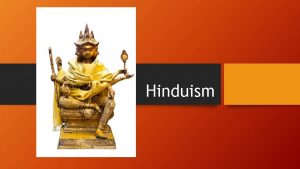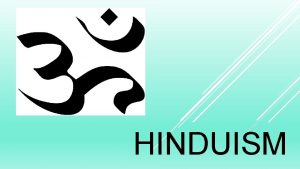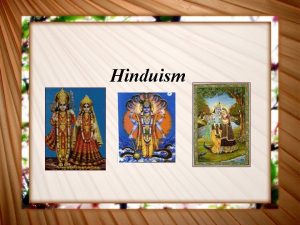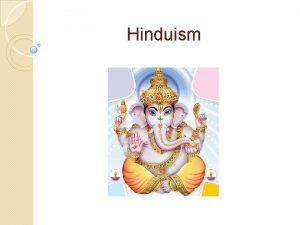Introduction to Hinduism An Introduction Hinduism is the















- Slides: 15

Introduction to Hinduism

An Introduction • Hinduism is the third largest religion in the world, with approximately 900 million adherents • It is also the oldest known religion in the world today • The origins cannot be ascribed to any single founder or a specific time or a single place


3 major texts of Hinduism • The Vedas – The oldest and most important is the Vedas (in 4 parts) • First in the form of oral histories • The Bhagavad Gītā (400 BCE) – It is perhaps the most famous, and definitely the most widely-read text of ancient India. • The Upanishads (400 BCE) – Focus on 1) meditation and 2) religious instruction with a guru

Brahman (the big guy) • There is one big God • The Vedas depict Brahman as the Universal Soul

Polytheistic? • Many Hindus believe in many deities • Key: These very interesting looking gods are not to be taken literally • The Hindu Trinity (the big 3): • After this top tier, there is a virtually endless list of second-string deities

Shiva • Shiva is the Destroyer • Even though he represents destruction, Shiva is viewed as a positive force • Shiva is limitless and unchanging. • Shiva is the supreme God in Shaivism

Brahma • Brahma is the Hindu God of Creation • Brahma is traditionally depicted with four heads and four faces and four arms.

Vishnu • Vishnu is the Preserver, he is most famously identified with his human and animal incarnations (AKA, avatars) – He manifested Himself as a living being in ten avatars. • They are (in order of avatar) – – – – – • (Fish) (Turtle) (Pig/Boar) (Lion man / from the torso upwards lion, below, human) (First fully human form as a dwarf sage who has the ability to grow very, very tall) (Fierce man / Hunter) (Greatest Warrior/ Ideal man) (Mentally advanced man) (Sage who is completely still) (Prophesied, yet to take place) For Vaishnavas, he is the Ultimate Reality or God. The Brahman.

Kali • Kali is the goddess of destruction • Kali wears a a necklace made from men's skulls

And let’s not forget Ganesha • Ganesha is one of the most well-known and venerated representations in Hinduism • The Lord of Good Fortune

Some Ideas That Unite Hinduism • 1) Reincarnation – Based on the idea that every living being has an eternally existing spirit – Reincarnation is the soul's cycle of birth and death until it attains Mokṣha (Moke-sha) (salvation) and is governed by Karma (see below) • 2) Karma – Karma rests on the idea of human free-will (not moved by God) – One’s actions determine the course of one’s life cycle & rebirth – You can't refine your soul overnight, however. Hindus believe it takes many lifetimes to achieve moksha

Some Ideas That Unite Hinduism • 3) Moksha – When a soul finally escapes the karmic cycle, it becomes one with Brahman when the last bodily incarnation dies. • 4) Stages of life – There are stages to “lives” that we all go through—some quicker than others – All humans seek: • 1. kāma (pleasure, physical or emotional) • 2, artha (material wealth) • 3. dharma (righteousness) – happens with maturity – learn to govern these desires within the higher framework • 4. mokṣha (salvation) – Results in ultimate happiness – Escape from the cycle of births and deaths

Some Ideas That Unite Hinduism • 5) The Caste System – The caste system is a rigid system of class – The lowest level of people are the untouchables. – The highest group are the Brahmin priests – The only chance to move is in the new life – Your next lifetime is your only hope for rising through the castes, live a good life and move to a higher level. – There are four hereditary castes

Criticism • Hinduism is criticized on the basis of some past and some current social customs – 1) Dowry: – 2) Sati: – 3) Caste System: • These trends are however on the decline in recent times due to a growing population of large well-educated Hindu middle class.
 Hình ảnh bộ gõ cơ thể búng tay
Hình ảnh bộ gõ cơ thể búng tay Lp html
Lp html Bổ thể
Bổ thể Tỉ lệ cơ thể trẻ em
Tỉ lệ cơ thể trẻ em Gấu đi như thế nào
Gấu đi như thế nào Glasgow thang điểm
Glasgow thang điểm Alleluia hat len nguoi oi
Alleluia hat len nguoi oi Các môn thể thao bắt đầu bằng tiếng bóng
Các môn thể thao bắt đầu bằng tiếng bóng Thế nào là hệ số cao nhất
Thế nào là hệ số cao nhất Các châu lục và đại dương trên thế giới
Các châu lục và đại dương trên thế giới Công của trọng lực
Công của trọng lực Trời xanh đây là của chúng ta thể thơ
Trời xanh đây là của chúng ta thể thơ Mật thư tọa độ 5x5
Mật thư tọa độ 5x5 101012 bằng
101012 bằng độ dài liên kết
độ dài liên kết Các châu lục và đại dương trên thế giới
Các châu lục và đại dương trên thế giới
















